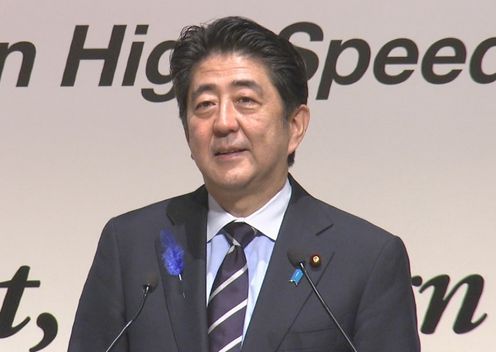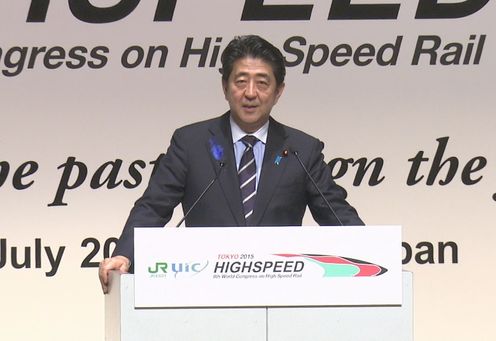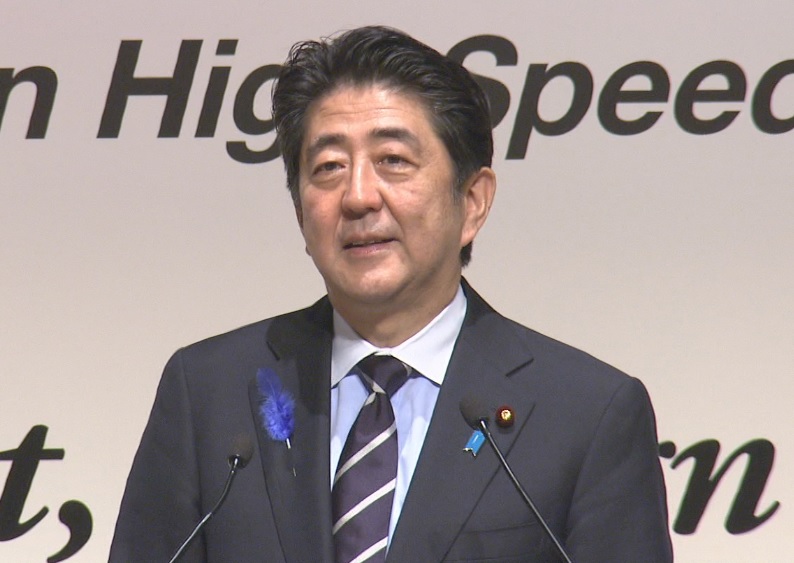Home > News > The Prime Minister in Action > July 2015 > Opening Ceremony of the 9th UIC World Congress on High Speed Rail
The Prime Minister in Action
Opening Ceremony of the 9th UIC World Congress on High Speed Rail
July 7, 2015

Photograph of the Prime Minister delivering an address (1)

Photograph of the Prime Minister delivering an address (2)
[Provisional Translation]
Prime Minister Shinzo Abe attended the opening ceremony of the 9th UIC World Congress on High Speed Rail, held in Tokyo.
In his address, the Prime Minister said,
“I am delighted that the World Congress on High Speed Rail of the International Union of Railways (UIC) is being held in Japan, the birthplace of high speed rail.
The theme of this year’s Congress is “Celebrate the past, design the future.” The Shinkansen began operating 51 years ago in 1964, the year that the Tokyo Olympic Games were held. At the time, the Shinkansen was known as the “super express of dreams,” and it was truly a means of transportation that fulfilled the hopes of the Japanese people. However, I have heard that in regard to its construction, there were numerous views such as “surely it is now the age of airplanes and cars,” or “the railway is already a declining industry,” or “building the Shinkansen is inappropriate for this era.”
What was the result? The number of annual users of the Shinkansen, which at the start of operations was no more than 30 million people, is now more than ten times as high at 350 million. During the same period, Japan’s per capita GDP has also grown over tenfold. The Shinkansen has truly supported the growth of Japan. It has brought about broad economic benefits through the reduction of the cost of time spent on travel and the invigoration of the flow of people for business or tourism. We can surely say that our predecessors who decided on the construction of the Shinkansen had great foresight.
The benefits of the Shinkansen are more than purely economic in nature. Its CO2 emissions are about one-seventh of those of a car, and do not exceed one-fifth of those of an airplane. If there were no Shinkansen, Japan would probably not have been able to achieve such a level of economic growth while also paying consideration to the environment.
This success of the Japanese Shinkansen has also had a large stimulatory effect on the railways of various other countries. High speed railways have been realized in many countries of Europe and Asia, and already the total length of the world’s high speed railway network is 20,000 kilometers. Moreover, high speed railway plans are currently being advanced in more than 20 countries of the world, including the United States, Southeast Asian countries, and India. We have now entered an era in which the high speed railways of various countries are leading global sustainable development while mutually spurring each other on.
I believe that in order to work towards the realization of a high-quality high speed railway network, it is important to compete at a higher level. I also feel that in such an era, I would like Japan to contribute to the world by sharing our Shinkansen technology widely with many countries.
I hope that all of you will take advantage of being here for this Congress and ride the Shinkansen to experience for yourselves its comfort and good service.
I would like to conclude my remarks by expressing my wish for the further development of the world’s high speed railways, and my hope that railways will serve as the driver for global socioeconomic development and generate the same kind of positive impact the Shinkansen has had on Japan. Thank you very much.”


